I’m always looking for new works to review for Because My Tears Are Delicious To You, an ongoing series on my own website. There I revisit some of the books I loved as a teen. Recently I put out a request on social media for readers to suggest authors and works now obscure that deserve mention. To my surprise, someone suggested Arthur C. Clarke’s Tales from the White Hart.
…How on Earth could Tales from the White Hart be considered obscure? Well…for one thing, the author has been dead for over a decade. The collection is an astounding ten twenty thirty forty fifty sixty-three years old, which is to say it’s as ancient to a new SF reader in 2020 as H. G. Wells’ The Time Machine was for the new SF reader in 1957, when Tales first came out.
Tales from the White Hart is also an example of a genre once popular that seems to have fallen into comparative obscurity: the barroom tale.1 The genre assumes a beloved old bar filled with regulars, one or more of whom is a talented raconteur. It’s a form made to order for SF magazines, the publications that once ruled the SF world. It’s also a form easily anthologized, as it was in Tales. As it also was for several other series of bar stories. Settle down, my friends, and nurse your beers or non-alcoholic beverages as I tell you of bar tale collections of the past…
Tales from the White Hart by Arthur C. Clarke
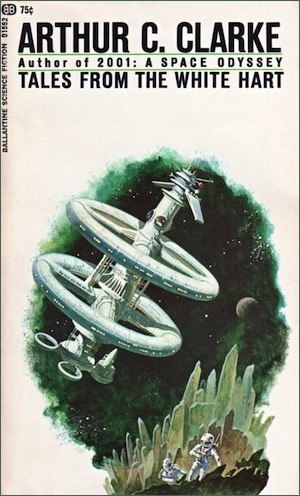
Set in the eponymous White Hart, this short collection features Harry Purvis, who tells quick tales that are entertaining enough to forestall rude questions about scientific plausibility (from a bar audience populated by thinly disguised versions of Britain’s best-known post-war SF authors). From death rays to man-eating-plants—if Harry hadn’t personally encountered a trope himself, he knew someone who had.
***
Tales From Gavagan’s Bar by L. Sprague de Camp and Fletcher Pratt (with illustrations by Inga Pratt, at least in my edition)
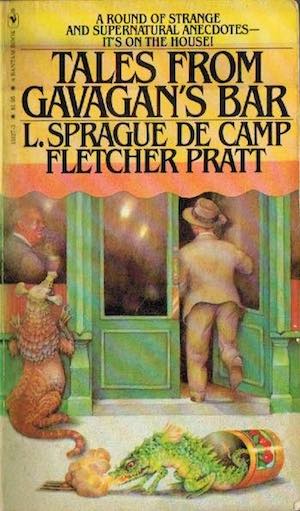
Of similar vintage to the White Hart tales, the Gavagan’s stories feature a broader cast of storytellers, each of whom is tells about an encounter with the weird, implausible, or divine. The stories barely count as short…any shorter and they would be Fredric Brown-style short shorts for which the postage needed to submit them would be more than the price paid by any magazine. Some are forgettable, but their brevity means that another story will be along soon enough. Enough of those are entertaining to make this collection worth a read.
***
Callahan’s Crosstime Saloon by Spider Robinson
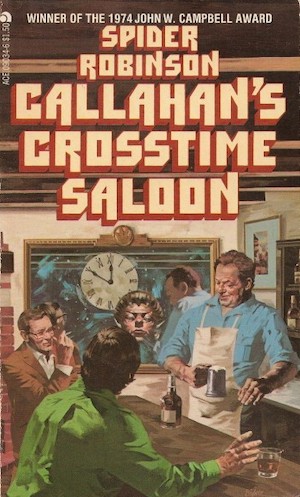
Initially set in a bar somewhere on Long Island, Callahan’s attracts a cross section of society’s damaged souls, most of them masculine2, who are seeking solace in alcohol and the company of others. A curious variety of new customers arrive and tell their stories, including ethically conflicted robots, time travellers, doomed telepaths, and others. Widower Jake Stonebender relates the various tales told by these weird visitors.
***
The Draco Tavern by Larry Niven
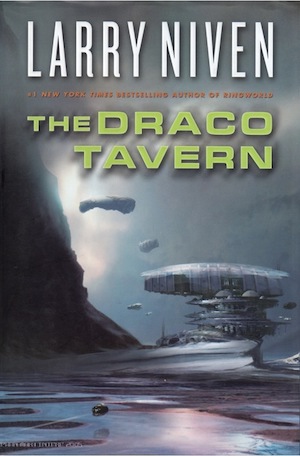
For the star-faring Chirpsithra, Earth is just another unremarkable world, a good place to visit but not to live. For Rick Schumann, owner/bartender of the Draco Tavern, the Chirpsithra and the other aliens who accompany them are his customers. As Rick’s tales reveal, these customers are an endless source of complications, of the sort of which stories are made.
***
All of the above collections are somewhat…let’s say vintage. This is not to say the genre is entirely defunct. There are modern examples3, one of which is currently sitting in my in-box, not yet read.
Fables From the Fountain (2020) edited by Ian Whates
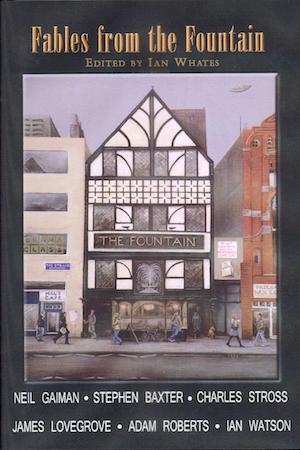
This anthology was intended as a homage to Tales from the White Hart. Editor Whates has recruited a roster of British SF authors, who have tried their hands at this venerable subgenre. I am curious what modern authors make of it.
***
No doubt many of you (pointed look at the Lord Dunsany fans) are astounded that I missed one or more of your favourites. The comments are, as ever, below.
In the words of Wikipedia editor TexasAndroid, prolific book reviewer and perennial Darwin Award nominee James Davis Nicoll is of “questionable notability.” His work has appeared in Publishers Weekly and Romantic Times as well as on his own websites, James Nicoll Reviews and Young People Read Old SFF (where he is assisted by editor Karen Lofstrom and web person Adrienne L. Travis). He is a four-time finalist for the Best Fan Writer Hugo Award and is surprisingly flammable.
[1]Perhaps because raging alcoholism is no longer considered as funny as it was a half century ago, there are a number of booze-driven stories, once famous, that have fallen from favour. Up to about 1980, for example, Thorne Smith’s alcohol-saturated fantasies occupied enough of the zeitgeist to win movie and TV adaptations. After 1980, not so much. It can’t have helped that behavior played for laughs like the Kerbys’ drunk driving (https://en.wikipedia.org/wiki/Topper_(film)) would be viewed with great disapproval today. (Modern readers justly outraged at the Kerbys can take comfort that their bad habits killed them before they could kill some innocent. Although I should note that dying had less effect on Marion Kerby’s homicidal tendencies than you would expect.)
[2]More aliens show up at the bar than women, at least in the first couple of collections.
[3]As are a number of stories in Chaz Brenchley’s upcoming “Everything in All the Wrong Order,” which I have as yet not acquired or read. Seeing as how it isn’t officially out. “Mystic Pop-up Bar” is another modern example. In this endearing K-Drama, the surly proprietor uses her bar to draw in potential clients for supernatural counseling. I won’t go on, as I’m hoping that one of the other reviewers on this site will review it in greater detail.











I don’t recall whether “Harry’s All-Night Hamburgers” sold alcohol, but “Tales told about an unusual restaurant” is at least a similar genre…
They are more fantasy than SF, but my favorite bar/club tales are the Jorkens stories by Lord Dunsany.
It’s a shame they’re not really available in an affordable edition…
I’m not aware of any SF anthologies, but at least in the webcomics and fanfiction worlds, the coffeeshop has supplanted the bar as “place to hang out with strangers and hear fascinating stories”.
Would Asimov’s “Black Widowers” be too mainstream?
The “barroom tale” format was also used extensively by P.G. Wodehouse, in the golf stories (tales told by the “Oldest Member” in the clubhouse), the Drones Club stories and the Mr. Mulliner stories. Given that the Wodehouse “England” is a version of Britain with a society that seems to be frozen in a kind of Edwardian-Jazz Age culture, one could argue that these are also fantasy or alternate-world fiction.
Dean Wesley Smith and John J. Ordover put together a six-novel Star Trek miniseries in 1998 called “The Captain’s Table,” which was very much inspired by White Hart, in which the various captains (Kirk, Sulu, and Pike from the original series, Picard from The Next Generation, Sisko from Deep Space Nine, Janeway from Voyager, and Calhoun from the prose-only New Frontier series) go to a strange bar that is only accessible to captains. You can stay and drink as long as you want, but you must, at some point, tell a story. The stories the captains tell make up the plots of the novels.
I edited a followup anthology in 2005 called Tales from the Captain’s Table with captains that had been added to the Trek pantheon, both onscreen (Riker, Archer) and in the tie-in fiction (Shelby in New Frontier, Klag in the I.K.S. Gorkon series, Picard in the Stargazer series, Gold in the Starfleet Corps of Engineers series, Demora Sulu in the novel Serpents Among the Ruins, and Kira and Chakotay in the post-finale novels for, respectively, DS9 and Voyager).
—Keith R.A. DeCandido
Michael Flynn has a series of these that has been cropping up in Analog intermittently over the last couple decades.
I’m surprised nobody has mentioned Lord Dunsany’s stories of Mr. Jorkens. Harry Purvis is essentially a Jorkens pastiche, and I assume Clarke and his readers were all aware of that.
@lakesidey: besides being of questionable SF-ness, I’d consider the Black Widowers to be in the “tales told in a club” genre, which is a bit different from the bar story. A touch more exclusive, perhaps.
Even the Star Wars universe has one of these collections: Tales from the Mos Eisley Cantina.
Remember, kids, when we used to be able to go to barrooms? That beer at the top made me nostalgic. And thirsty.
God bless Callahan’s! Those stories, read and reread from the greasy pages of somebody’s discarded issues of Analog that I picked up from library sales, got me through some long, lonely days as a teenager. I figured that if somebody could imagine people being so downright decent to one another in spite of everything, then somewhere it had to be real.
@10: I remember that one! The upshot of the book is that there were so many ways that Luke could have never walked out of that bar again. Wretched hive indeed.
Tales From the White Hart has the first instance I know of in fiction of noise cancellation, with a pretty good description of how it works. The description of so many BBC Dramas that get exported to the US is very fun. The White Hart is extremely masculine, something Clarke himself hangs a lampshade on in one of the stories.
@5: I was going to mention the Wodehouse stories too; Wodehouse’s England absolutely is a fantasy world. The Mulliner stories, in particular, include some outright magical elements– consider the mesmerizing effects of “The Smile That Wins,” or the strength and confidence imparted by the “Mullier’s Buck-U-Uppo” tonic (a close relative of the Felix Felicis potion, really). And “Honeysuckle Cottage” is certainly a haunted-house horror tale.
I’d also mention the “World’s End” collection from Neil Gaiman’s “Sandman” series, in which a group of strangers hides out in a bar, telling stories, while a “reality storm” rages outside.
I suspect C. J. Cherryh placed Hoh’s Tavern in Merovingen with the thought that her shared world guest writers might use it for that purpose, a la the Vulgar Unicorn – if I recall, it was one of the raft of Merovingen Nights related terms she actually went and trademarked. As it turned out, pretty much all that happened there in the stories was Mercedes Lackey and Leslie Fish Rif and Rat had gigs.
I suspect C. J. Cherryh placed Hoh’s Tavern in Merovingen with the thought that her shared world guest writers might use it for that purpose, a la the Vulgar Unicorn – if I recall, it was one of the raft of Merovingen Nights related terms she actually went and trademarked. As it turned out, pretty much all that happened there in the stories was Mercedes Lackey and Leslie Fish Rif and Rat had gigs.
The tale-being-told frame story set in a British gentleman’s club or a drawing room on a rainy evening was the standard format for Victorian ghost and weird adventure stories so it’s been popular a long time.
In the present where meta and weird are normal and readers are easily bored with set up, the frame story is much rarer.
Neil Gaiman, “Sandman 8: World’s End”.
And does the Man In The Moon tale Frodo tells at the Prancing Pony count?
“The World of Commander McBragg” from the “Tennessee Tuxedo” cartoon.
I was going to suggest the Mr Mulliner stories! Considering the lack of harsh realism in PGW’s stories, it’s possible to suggest they had several fantasy-adjacent elements, like a patent medicine that’s effectively a magic potion for making people brave enough to stand up even to Bishops, or a dignified cat encouraged to public drunkenness, etc.
I loved Callahan’s and dropping by Mary’s Place would be fun, but I always really wanted to visit Lady Sally’s instead. I have a high tolerance for puns. I know there is a similar style book in D&D settings but all I can think of is Tales of the Yawing Portal but that’s not stories. There’s Last Call at the Nightshade Lounge by Paul Kruger. It’s not an anthology just a bar where monster slayers hang out. These days it’s more diner’s and coffee shops.
I read Dad’s White Hart collection (the exact edition pictured above) multiple times in my younger days. Then for many years I thought it was lost, but I was moving and it turned out to have fallen behind a dresser or some such, and was safely returned to my shelf. I should read it again one of these years.
The Inn/Tavern sequence in THE DRAGON WAITING is a favorite of mine
See also The Old Phoenix, the interdimensional tavern in Poul Anderson’s works, where the Proprietor’s charge for food, drink and lodging for one night is that they tell him their tales.
@23 Happily, The Dragon Waiting just got its rerelease, so it’s moving very, very close to the top of my reading queue even as we speak.
That’s a terrible cover for Tales From The White Hart – all the stories take place on Earth.
You really have to wonder whether some of the writers were alcoholics too.
This was the cover of my MMPB White Hart:
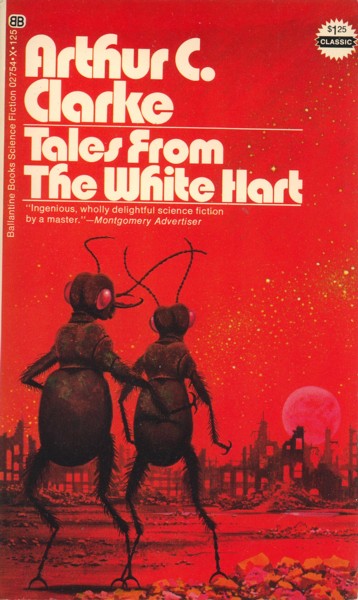
[I seem to have lost the ability to embed images]
Yes, I do remember being confused initially by the lack of space stations. But I also would’ve been confused by the lack of giant, humanoid ants. (Unless I’m misremembering the stories.)
Stephen King contributed to the “barroom tale” genre to frame his novella “The Breathing Method.” (Don’t read it if you have a weak stomach.)
John Ostrander’s Muden’s Bar backup stories from Grimjack comics deserve a mention.
It is a novel, not a short story collection, but Cowboy Feng’s Space Bar and Grille by Stephen Brust was pretty good.
I heard a BBC radio play this week – but on their repeats channel “Radio 4 Extra” – of H.G.Wells’s “The Inexperienced Ghost”. It’s in a golf club that allows members to sleep over, is that usual or does it reflect their alcohol,consumption? As in, a country pub that merely happens to have a golf course next door.
@13 re “The White Hart is extremely masculine” –
In around 1970 my brother moved to Bradford in Yorkshire to do a post-grad research degree (on the post-war Yugoslav banking system). A few years ago he wrote an a capella song remembering people and things that were around at the time but are no longer (he still lives there) and one verse goes:
When I first came to Bradford, beer was two and six a pint
So I took my London girlfriend for a drink on her first night
As we walked in the cry went up “where’t f*** d’you think y’are?
This is Yorkshire, and women are not welcome in this bar”
This was 15 to 21 years after the stories in the White Hart collection! Though most are from around 1956-57, one is from 1949 (the same age as my brother).
I remember the noise-cancelling story from the White Hart collection, but none of the others ring much of a bell.
My favorites: Callahan’s; The Vulgar Unicorn; The Joy House/The Palms; The Compass Rose; The Gilded Lilly; and Cowboy Feng’s.
Sterling Lanier did a series of bar stories. https://en.m.wikipedia.org/wiki/The_Curious_Quests_of_Brigadier_Ffellowes
Huh. I just bought Lanier for review…but not that one.
I always liked the elephantus frumenti from Gavagan’s.
I would definitely recommend Tales from the Spaceport Bar, a 1987 anthology edited by George Scithers and Darrell Schweitzer. It has stories from many of these series, and lots of non-series ones as well. There was a sequel a couple years later.
If it hasn’t been made entirely clear by now, Dunsany’s Jorkins stories are set in the Billiards Club, not, strictly speaking, a bar. Although the usual reward for Jorkins’ stories is a whiskey & soda.
Can’t believe I forgot “Hanrahan’s Bar”, by Cynthia McQuillin – a song set in a spaceport bar. It’s only a regular part of my repertoire…
David Petersen’s Mouse Guard has three separate volumes of “Legends of the Guard”, each tale an anecdote from a different mouse, written by a different author and artist combo in a whole variety of styles, wrapped in a Tavern framing story. The best storyteller in setting as picked by the tavern owner gets their bar tab paid for the year.
Clarke and Stephen Baxter collaborated on one final White Hart story, “Time, Gentlemen, Please” for a 2007 limited edition issued in honor of the book’s 50th anniversary. It’s rare and expensive; I’ve never seen a copy. Still, quite a timespan between the first and last story.
There weren’t giant ants in Tales from the White Hart, but there was a story about mutant ants that were intelligent and had discovered fire…
I wonder what the record is for the longest span between first and final story in a series, penned by the same author?
James White’s “Sector General” ran from 1957 (November publication) to 1999: around 42 years then.
By ISFDB http://www.isfdb.org/cgi-bin/index.cgi Jack Vance’s “Dying Earth” goes from 1950 to 1985.
Isaac Asimov’s “Foundation” is 1945 to 1993.
Andre Norton has several long runners…
Are we talking genre (are we talking bar stories? How long can one liver hold out?) Sherlock Holmes goes from 1887 to 1927 by the original author. The Wizard of Oz, 1900 to 1920. Nero Wolfe by Rex Stout, 1934 to 1975.
Wikipedia says that Agatha Christie’s stories of detective Hercule Poirot appeared between 1920-1975, 55 years; a first draft was rejected in 1916, the last “new” title was “Elephants Can Remember” (1972), and his last adventure, “Curtain” (1975), she wrote in the early 1940s, during the Second World War, and kept originally for posthumous release. So, 56 years of writing. I think “The Big Four” at least might count as science fiction; it’s an odd romp like a James Bond movie or perhaps the Fu Manchu stuff, against evil masterminds, and terrible destructive inventions are involved.
Tradition proposes that Moses wrote the first five books of the bible, and lived to be 120; events in his biography cover at least 40 years of course, but when did he start publishing?
@45 P.G. Wodehouse’s first Bertie and Jeeves short story was published in 1915 and the last Bertie and Jeeves novel was published in 1974, a run of 59 years.
A truth well-known in SF circles—and which a reader not privy to any insider knowledge might easily guess—is that the White Hart is a fictionalized version of a pub Clarke frequented with his friends: the White Horse. From the 1940s onward, London’s science fiction fans met regularly in this Fetter Lane establishment. Many of the youthful fans of the Thirties (whose antics were sketched in fanzines) had, in maturity, become pro SF authors or editors. On Thursdays, they mingled there with younger fans and older friends from all walks of life.
Rob Hansen, the admirably diligent historian of UK fandom, has placed online an interesting 1954 article. “Tales from the White Horse,” by Frank Arnold, portrays the publican, Lew Mordecai, and attempts to convey the spirit of a time Arnold experienced as a golden age.
The fannish gathering eventually moved to another pub, the Globe, and later another; London fandom persisted, and kept up regular meetings for decades afterward.
The White Horse was much older than SF fandom, by the way; James Pollard painted its portrait in 1865.
@2: Hard to find in the US. If you can, for instance, order from Canada or a few other countries, Delphi Press has the (almost)-complete Dunsany available. (I am not affiliated with them in any way.)
https://www.delphiclassics.com/shop/lord-dunsany-2/
I will add that the Delphi Press stuff is badly proofread (or not proofread at all); so, for instance, a passage has a quotation beginning with double-quote I, and the OCR software begins the quote with T. This happens a lot, and is quite distracting.
Owlswick Press had a few Jorkens stories in some of their Dunsany collections, but they went away years ago, alas.You might be able to find a used copy of “The Ghosts of the Heaviside Layer and Other Fantasms,” containing a Jorkens story not otherwise published except in a 19th-century magazine.
@35: Dammit, I was going to mention Ffellowes, and you beat me to it!
In 2012ish DAW published Tales from the Ur-Bar a loosely connected set of tales based in the bar of Giglimash’s wife.
Thanks for choosing my favorite (Di Fate?) artwork for the Clarke collection—which I do own in this guise. I read these stories with delight way back when—and can probably quote “Armaments Race” with some accuracy.
Not a collection but a single story: Columbus Was A Dope by Heinlein
Another bar collection – Tales of the Screaming Eagle by Clayton J. Callahan.
A fun light hearted collection of stories that end up fitting into a complete story.
I got it as an inexpensive eBook and totally worth the investment.
I don’t know how I missed this article! Reading it for the first time on Oct 8th. @50 While I love “Armaments Race” I can think “Cold War” just beats it out as my favorite story in the book.
In a complete coincidence, I have Lanier slated for review. Hint: it’s the one with war moose.
@15 @16 True, at least, IIRC (Cj “invented” the Vulgar Unicorn tavern), but credit (or give blame to, if you wish) Bob Asprin for getting the BNW’s of the era to write for his vision of a “Thieves World.” The Vulgar Unicorn stuck so well (thanks Cj Cherryh!) that one of the later anthologies set in the Thieves’ World was, “Tales from the Vulgar Unicorn”
Re: Callahan’s while the idea of a bar means people would drink, there was actually (beyond the first round or two) very little drinking going on. It was a bar that you couldn’t find unless you needed to (that’s how Jake stumbled onto it)
I didn’t see anyone comment on Mystic Pop-up Bar, so I will. I don’t think it is strictly comparable to the bar stories. For one thing, there’s no real story teller, though there are continuing characters, including the, proprietor, a ghost who is trying to redeem her soul. Instead the stories are all acted out. But the fact that there’s an overarching story that ends with the series makes it something other than a collection of short stories. I thought Midnight Diner was a better example of the genre, except there was no supernatural component. Still, Mystic Pop-up is worth watching. It’s the only show I’ve seen where the disclaimer includes “Not based on a real religion.”
There was a fine Callahan’s group on Usenet, and now there are two heritage Facebook groups as well (on one of which I was reminded of this excellent if too-brief post).
I’ve been a regular at all 3 internet versions of Callahans for going on 26 years now. and have always loved the stories, along with some of the other tavern stories, including the ones from the Nightside books, the Draco Tavern, Cowboy Feng’s Spacesuit Bar and Grill too. I also moderate one of the facebook versions,. which has over 2,500 members
It’s not obscure, but don’t forget The Name of the Wind by Patrick Rothfuss. Kothe tells one hell of a barroom story.
Was it the Phoenix Tavern that Kimball Kinnison turns up in? (Not named, but the glowing thing on his wrist can only be interpreted as a Lens. But it might be a different bar.) This is a great thread, and I find I have at least a couple of these on my shelves ready to reread (the Callahan’s collection and I think the right Anderson book(s)) – thanks for the inspiration!
John Ford, George Scithers and Barry Longyear wrote a parody bar story in 1980 called “What’s Wrong With This Picture?” by the way. It’s collected in the book that #38 mentioned.
@@@@@ 24, Russell H:
See also The Old Phoenix, the interdimensional tavern in Poul Anderson’s works, where the Proprietor’s charge for food, drink and lodging for one night is that they tell him their tales.
The Old Phoenix first appeared in A Midsummer Tempest. Anderson also wrote two short stories set in the Old Phoenix. House Rule and Losers’ Night.
The inn also appears in Harry Turtledove’s coda to Three Hearts and Three Lions; The Man Who Came Late
@57 and @58 I went to the Usenet Callahans, I’m in both of the Facebook groups and I hung out on the Callahan MU*. There have been several virtual incarnations in Second Life as well.
Love Callahan’s.